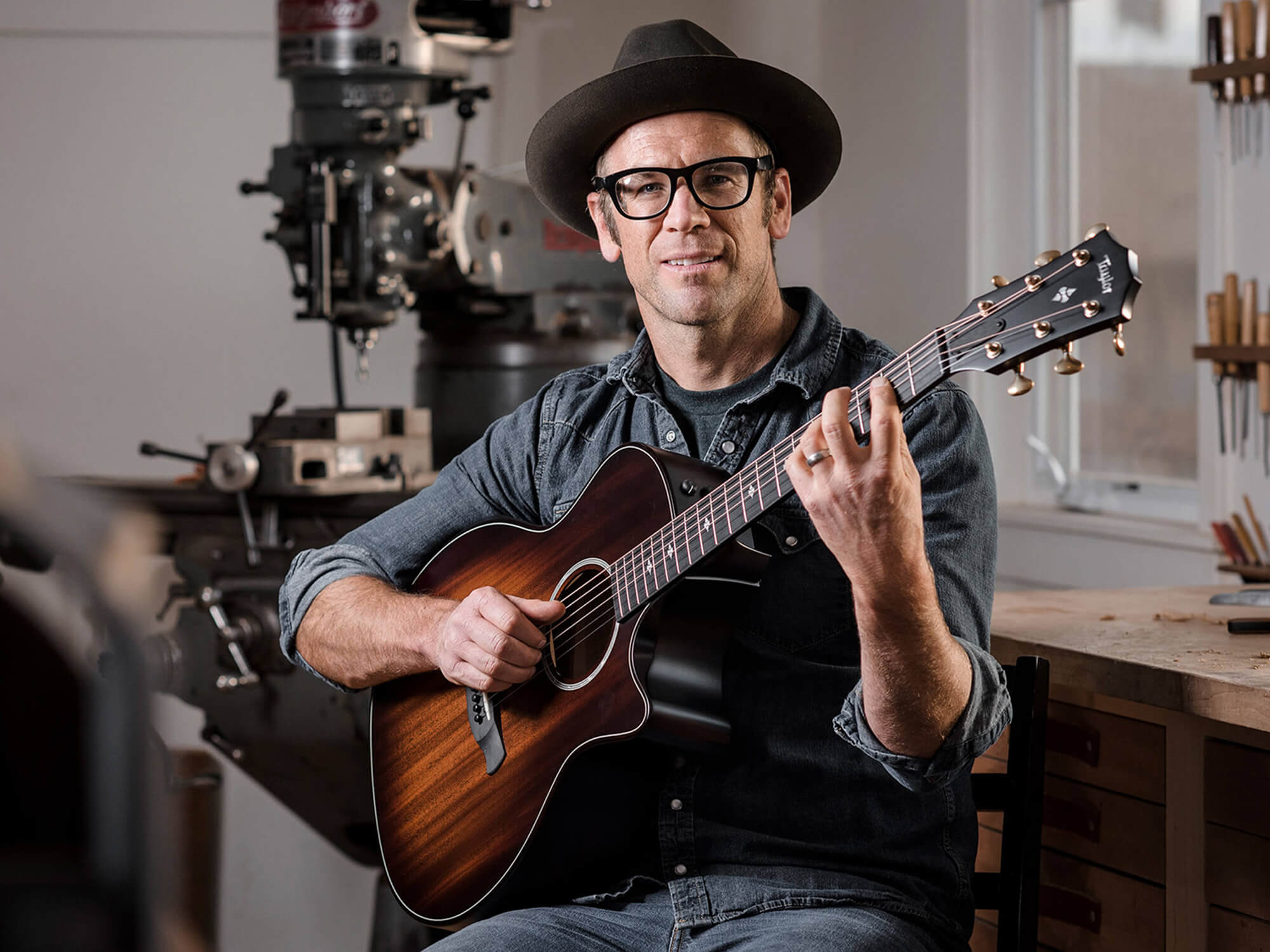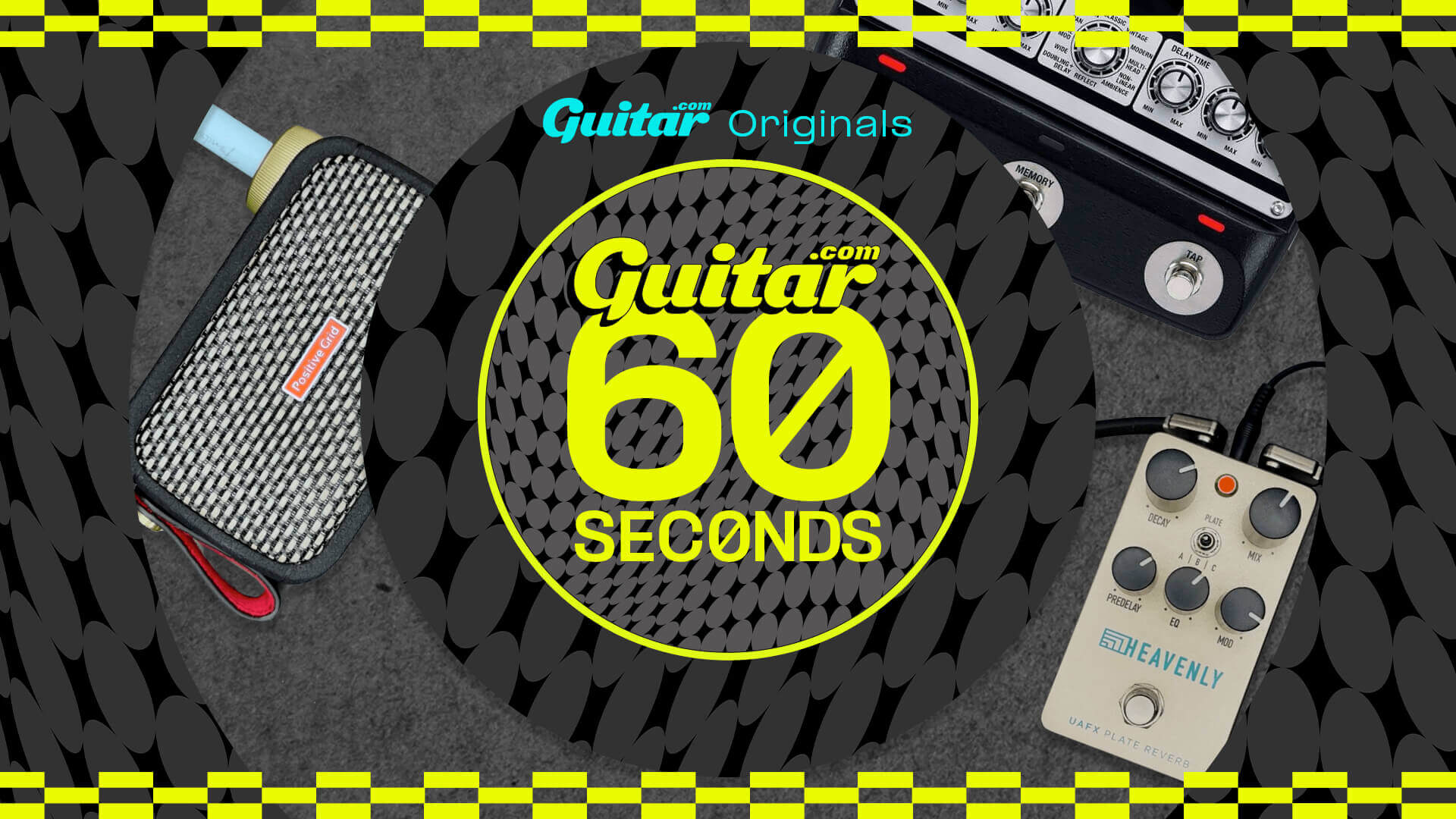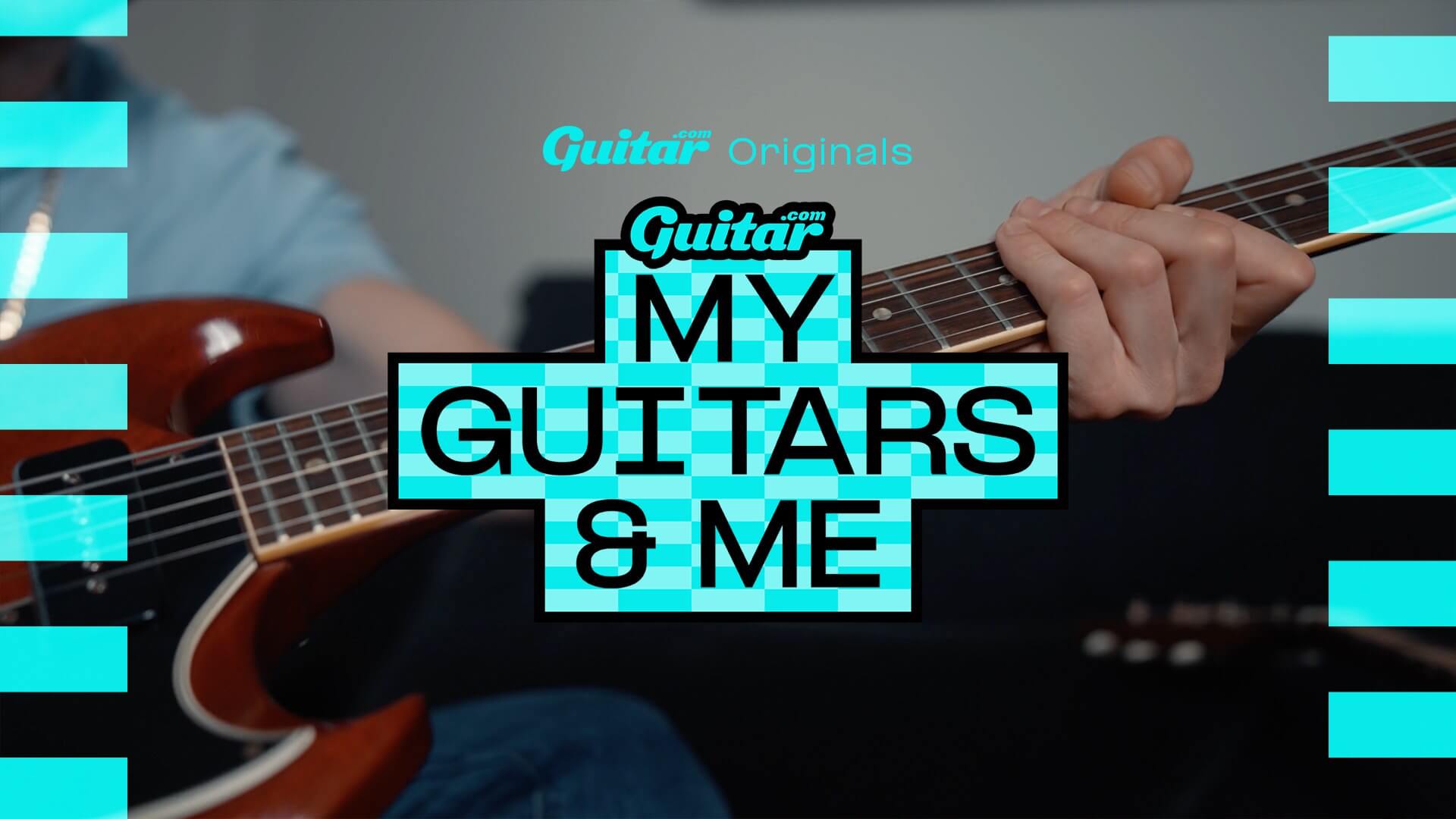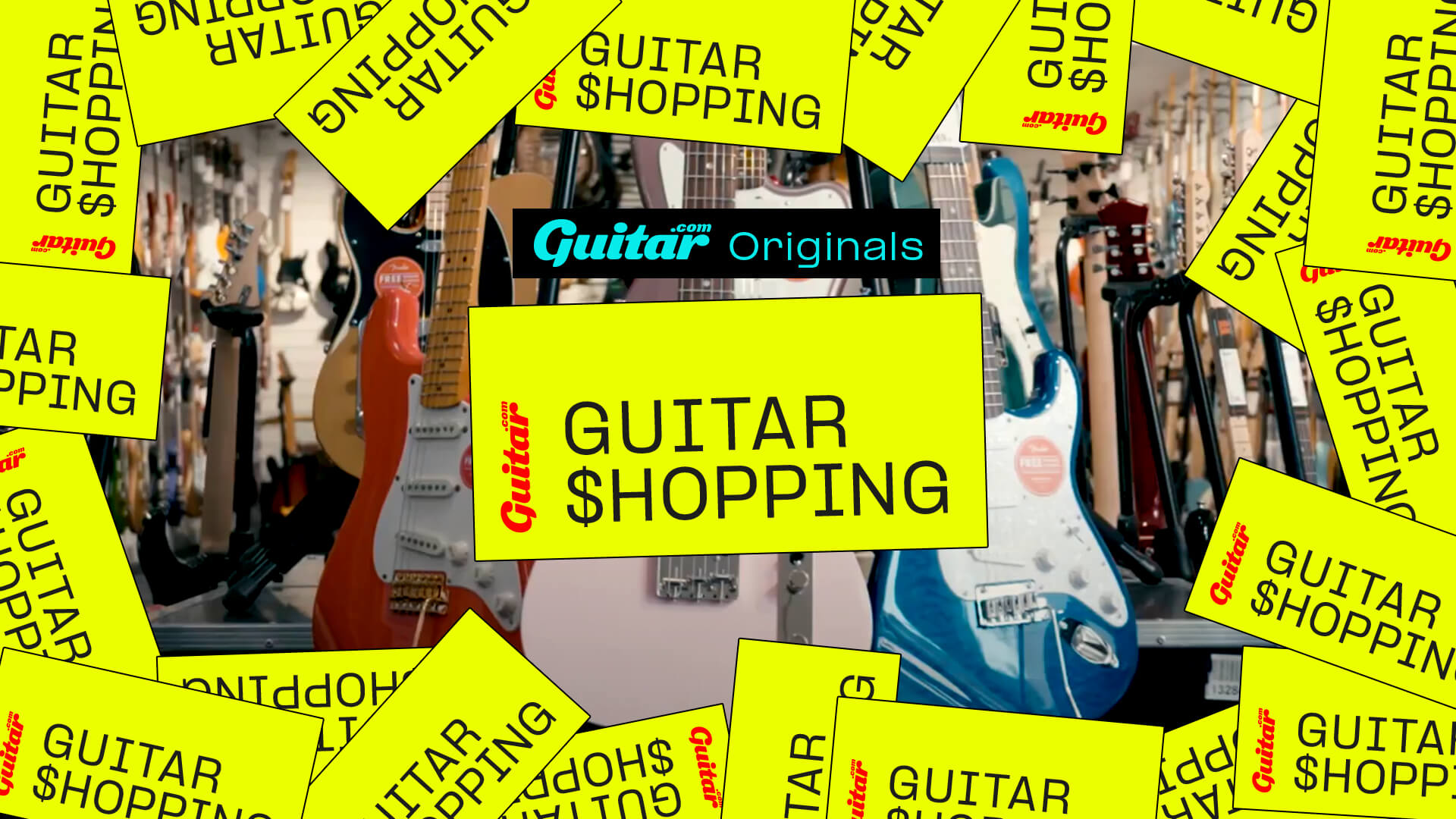“You can’t change history every single month!”: Taylor’s Andy Powers
Taylor’s Andy Powers on how solo building made him a better CEO, the challenges of innovating in a post-COVID world, and how guitar makers are going to have to evolve to meet the needs of modern musicians.

Andy Powers, CEO, President and Chief Guitar Designer at Taylor Guitars. Image: Eleanor Jane
Andy Powers never thought his career would end up here.
But the reason for it isn’t a lack of ambition or drive on the Californian’s part – you don’t get to be the CEO, President and Chief Guitar Designer at Taylor Guitars by accident. And the transformative impact he’s had on Taylor since he put aside a successful career as a boutique luthier to join the brand in 2011 has been as profound as anyone else in the brand’s very nearly 50-year history except founders Bob Taylor and Kurt Listug.
- READ MORE: Andy Powers on redefining the “quintessential Taylor guitar” and the future of scarce tonewoods
Instead, the fact that he never thought his path would take him to the top job at one of the world’s biggest acoustic guitar companies, is because he’s never really thought about it as a path at all.
“I never really thought of it as a career, I think that was probably my first mistake!” Powers jokes. “I just really love the guitar. I love building instruments. I love playing instruments. I had fallen into guitar making, almost by accident – I was a little boy when I started. So I don’t really know anything different than building instruments.”

It is a strange and rare thing to discover your life’s purpose as a seven- or eight-year-old, but that’s when Powers began repairing and building instruments at home using his dad’s carpentry tools, and began doing it for money when he was barely a teenager.
Ever since then, he’s never stopped building instruments – fitting it in around his myriad other passions, which include but are not limited to, surfing, cars, making surfboards, cultivating fruit trees and, just to rub it in, being an absolutely lights out guitar player. There’s also the small matter of the new electric guitar company he’s just founded, Powers Electric, which we don’t even have time to talk about today. The man’s dance card is stacked.
From the outside it’s hard to imagine when he has time to sleep, let alone be one of the most creative forces in modern acoustic design while also doing what is effectively two jobs amalgamated into one. To hear Powers talk about it, though, his early exposure to the world of solo guitar-making gave him a great grounding in how to run a much bigger business properly.
“You realise there’s all these parts that go alongside your instrument-building life,” he reflects. “There’s an archtop builder, Bob Benedetto. And he once told me, ‘Well, the only way you can successfully build a lot of instruments is to sell a lot of instruments’. And it becomes immediately true if you’re building a guitar one at a time. Because you’ll build that instrument, and you need to sell it so that you can buy materials to build the next one.

“And so you get into that cycle and so you sort of learn all of the aspects of what becomes a business. I mean, in some ways, you think of almost any business and realise, well, it started as someone – a founder – who is very interested in making something or doing something. You know, they’re asking themselves, ‘Well, what can I do to serve my customers?’ ‘What can I make for them?’ ‘What can I offer them?’ And then you get busy enough that you go, ‘Darn, I need to get some more materials, and I gotta figure out how and where to get materials regularly.’ So you start to look at what eventually gets labelled ‘supply chain’.
“What starts as simply, ‘I need to get some wood’, or ‘I need to get some tuning machines’, or, ‘I need to buy some strings’ or whatever it might be. You look at selling these and go, ‘Well, eventually, I’ll run out of friends to sell them to, I guess I need to meet somebody else who knows more musicians!’ So you talk to a guitar store somewhere? Or you look at some way to go, ‘Hey, I’m making these neat instruments, do you know some players who’d be interested in it?’ You call that a sales channel eventually.
“So you start with some sort of interest. And the business kind of gets formed organically as it grows. So if you were to ask me when I was, say, 10 or 12, and building guitars, and say, ‘Well, would you imagine yourself as a CEO?’ I’d go, ‘Well, what do those letters mean?’ I wasn’t ever thinking about that. I was just really into the instrument.
“There’s plenty to think about, there’s plenty of plenty of work to do. But at the core, the instrument and music that gets played on them – that’s still the thing. That’s what makes us get up every morning and come to the shop and go, ‘We’re gonna make some magic – this is cool!’”

Guitar Enthusiasts
Spending any time with Powers, his enthusiasm and passion for the instrument is infectious – but there are scores of wonderful, talented and legendary guitar makers out there making fabulous instruments, but they’re also not trying to reinvent the wheel while they do it. For Powers however, you look at innovations like his revolutionary V-Class bracing, and you see a man determined to tackle issues and problems with the acoustic guitar’s fundamental design that few would have the eye and ear to notice, let alone tackle.
I wonder if his desire to enhance and innovate – whether that’s with guitars, cars or surfboards – comes from being the sort of person who is never happier than when he has a particularly tricky problem to solve?
“I’m not sure that I like having problems to solve,” he counters. “It’s more that they come and find me! I look around, there are so many interesting things to see and do. And a lot of a lot of the things that I’ve, I’ve grown up with, they’re still the same interests. And so they just start to take on more and more and more curiosity, the more you learn about them, or the more you participate.
“I mean, I grew up in Southern California, so I was surrounded by the surfing culture and hot-rod and car-craft culture. And at the same time, this architecture thing, and there’s a lot of agriculture around still. So there’s all these interesting things that sort of overlap. And for me, guitar making ends up sort of, interestingly, tied to a lot of those things. In one way or another.

“Like, one of my interests is that I like raising fruit trees. So I like growing avocados and oranges, and you know, a bunch of different things, because I live by the coast where it never really gets that cold in the winter. So some of these things don’t get damaged easily, so you can grow fruit year-round. My mom did it. Both my parents are kind of still into that a little bit, at a hobby level. And I think it’s sort of miraculous to watch.
“But then you start to see the parallel between harvesting, growing, planting, harvesting, and the way that you’re going to acquire wood, plant for future generations, and create something out of what you have available to you. Those become very parallel thought patterns. Yeah, right. And so the way that I look at growing an apple tree for future seasons, this is not different from growing koa trees for future generations of guitars. These are very similar things.”
It sounds, I venture, that you’re someone who regularly gets struck with the solution to a conundrum in one of his interests while doing something entirely unrelated in another…
“All the time,” he smiles. “Because there’s this thing, I think the guy’s name was [Jeffrey] Madoff – he was a psychologist back in the 50s or 60s, something like that. He was trying to define the essence of creativity, and he was doing some work with what people call associative memory. And as he defined it, the idea of creativity was the formation of a connection between two previously unrelated ideas. I think that’s probably pretty close.

“Because you’re taken to things. And then you realise there’s some sort of connection here, that means that I could borrow a little of this thought, and apply it over here… and now I’ve got something really new. That’s an interesting way to do this.
“In fact, that’s kind of where the V-Class idea came from. It was literally watching ocean patterns, watching waves from a bluff going, ‘I’m bummed because it’s windy and the surf’s not great for riding. Oh, wait a minute… This is actually kind of parallel to what my guitar is doing. That’s moving with really, really fast wave patterns… this is moving really slow. I can watch, and in that form, it’s moving faster than I can hear it… Ohhhhhhh, here’s a flaw that I could correct. I need to try going this direction rather than the way that I’ve always gone before.’ So it can spark those fresh ideas.”

The Pace Of Change
The pandemic was a strange time for guitar makers – on the one hand, pretty much everyone’s order book had never looked healthier, and the demand for instruments surged so heavily that it led to some brands making ultimately costly bets that this would continue on afterwards.
For many companies, however, the need to fill back-orders has led to a slowing down in the pace of iteration we’re used to seeing. Taylor was not immune to that – we’d got used to seeing the brand drop something game-changing every few years pre-pandemic, but in the years since it feels like maybe that pace of revolution has slowed a little.
Without wishing to tap my watch in his direction, I can’t help but wonder if the various pandemic-adjacent issues – supply chain problems, difficulty clearing back orders, and the increased difficulty in getting people in a room to work together – has stymied some of Taylor’s ambitions in recent years. Powers is reflective.
“It’s kind of a fun scenario, because you think about it and go, ‘Well, let’s change the paradigm… and put that change on a yearly cycle? How do we do that? You can’t change history every single month!” he says incredulously.

“During the pandemic, I think amongst some makers, we were a little unique because we continued forward with some of our projects. So, for example, during the pandemic, we designed, tooled for and launched what we call our Grand Theater guitar. So that was a totally new bracing pattern, totally new shape, totally new neck, totally new scale length, new sort of instrument platform and a new size range.
“Then, in what was more of a direct pandemic thing, we started building what we call the American Dream series. Which is, in a way, a more minimalistic form of guitar, but that’s still a solid wood V-Class guitar, built in El Cajon.
“So, yeah, there’s some things like that that we did… but there are some other projects that we paused on, because, like you pointed out, there are simply so many guitars to build! If I’ve got 10 of these that are on backorder. I just don’t feel right about going to someone and saying, ‘Well, you can’t have the 10 that you ordered, or that you asked for already. But you could have this new one! You want that!?’ That’s weird.
“And so you’re right in that we, as well as a lot of other companies, looked at it and went, ‘Man, we have to just pause on this project in order to focus on the work that’s already in front of us taking all of our time and attention and effort, all of our materials, all of our available waking hours, all of the glue all of the finish, all of us! Okay, that’s all we can make right now.’ And so there was definitely a lot of that.
“And so in the course of this year, we’ve actually launched more new instruments than we’ve ever launched in one year. Some of these are not super heavy lifting kinds of development projects, but they’re interesting things to do. There are projects that we had queued up, that during a pandemic we went, ‘Yeah not now. Not now. Can’t do it. Not yet. Just wait, just wait…’ And so now we’re kind of clearing the table, so to speak.”

Future, proofed
If Taylor is clearing the table, then, you get the sense that they’re getting ready to set it for something pretty special coming up in the near future. While Powers of course won’t be drawn on any of that right now, there’s a glint in his eye when we start chatting about the rapid change in popular music in recent years and how builders like him can respond to that.
“I think what I’ve noticed in the last several years, but even going back a little further, probably the last 10 years, say – it’s that the direction forward is not a single direction,” he explains. “And by that, I mean you look at a musical trend. And in previous decades or previous eras, you tend to see all of what we’d call popular music start to go in a single direction. And so you’d hear a lot of similar sounds that were the flavour of the era.
“And what I see now is more like a fragmentation of stylistic influence. There are so many different directions that a musician could go so many different avenues for releasing your music, and how that affects what music you do play, perform, write and release. There’s so many different stylistic influences that you could draw from. There’s so many different aesthetics, so many different sounds. It’s so wide and varied, and because it’s so accessible, there’s an audience everywhere for all of it. Like there’s room for everyone.
“And so to me that makes for particularly fertile musical ground. I mean, you look at Apple Music or something, how many different genres could you name? There’s so many, you probably couldn’t name all of them. The days of going to a record store and going, ‘Okay, here’s our rock records, here’s our blues records, here’s our country records, here’s our jazz records…’ We don’t categorise like that anymore.

“You’re looking at artists as individuals, and they might make an album’s worth of music that is so uniquely individual to that person. They’re using all these interesting sounds. It’s just different than it used to be. And so when I look at that, I think the trend forward is a wider variety of instruments and a wider variety of sounds to fit into unique and wide ranging styles that a musician could draw from.”
As befits a man who has recently started dipping his toe into the electric guitar game, the example he cites for the wild and radical nature of musical change in 2023, he points to our old friend, the stompbox.
“How many pedals are there?!” he exclaims. “How many different types of sound are you going to make with an electric guitar? I have no idea! I don’t think that you could actually add up how many potential combinations of sounds you could get.
“I mean, you take a hundred pedals, and you could put them in any order with any mix, any different settings… the possibilities are infinitely variable! And so many of them are viably musically creative sounds. There’s no limit to what you can do!”
Powers has made his career by redefining the limits of what people believe is possible with acoustic guitars – don’t expect him to stop now.



